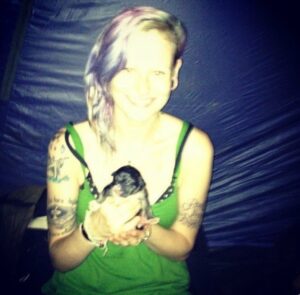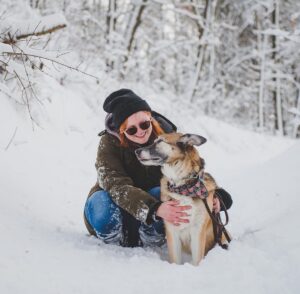I lived with a dog named Althea, who belonged to my roommate, during my undergrad. Every year, my partner, our roommate, and I would go to a summer solstice festival. The year Althea was pregnant, my roommate brought her to the festival. The first night there, he retired to his tent to nap in preparation for the evening’s festivities, and my partner and I walked with her around the festival grounds. I noticed her water break and we had a friend fetch our roommate while we took her to his car, a small place we knew she felt safe. She gave birth to eight puppies that night, as the sky opened and rain poured from the sky.
I remember catching the puppies, one by one, letting Allie clean them, and then handing them to my partner to hold in a towel while she birthed the next. Luna was the sixth puppy born. She had a white-tipped tail and a white crescent moon marking on her forehead. She was the smallest of the litter, but not by much. I knew immediately that she was for me, and I for her.
Over the next few years, Luna was by my side while I finished my undergrad, kicked my doctor-sanctioned opioid addiction, and moved to a new community. She couch-surfed with us during a brief period of homelessness, came with me to my first big business job to sleep under my desk, greeted me exuberantly when we brought our son home from the hospital, and hiked hundreds of kilometres with my son and I during the pandemic.

The first sign she was unwell was that she was panting a lot. Then, she started having accidents. I took her to the vet, expecting an antibiotic for a UTI. But our vet did an x-ray and discovered a large tumour. She told me that our girl was in pain and only had a few weeks to months left. I was shocked, and so was my partner when I shared the news. It was his first real experience with grief, but I was a seasoned professional. We both spoke with therapists and chose to try to make the end of her life as good as possible.
I was tortured with the idea of choosing to euthanize her. I didn’t know how or when we would be able to make that call. My therapist told me that she had lost a dog the same way and that the day would come when she would look me in the eye and I would know it was time.
These are three things that helped:
1. Connecting with a therapist, my partner, and my peers who could relate.
It helped a lot to feel like other people in my network could relate to what I was going through. It felt so heavy and it helped to talk about it and to know I wasn’t alone.
2. Taking her to an indoor dog pool to do her favourite thing.
We wanted to honour her things that we knew brought her joy. Luna loved chasing balls and swimming in Lake Ontario, but it was too cold to take her to the lake. So we found an indoor dog pool and took her weekly. It seemed to help with her pain and it helped all of us to find joy amidst the sadness.
3. Stamping her paw prints.
I ordered a baby footprint kit online and stamped her paws. I framed one and hung it on our living room wall. One day, I hope to get it tattooed.
Finally, the day came when, just as my therapist had told me would happen, Luna looked at me and I knew she was in pain and didn’t want to suffer anymore. We made it through a heartbreaking night and drove her to the vet as soon as it opened in the morning. I told her she would feel better soon. She leaned into me, I held her, and my partner and I both told her we loved her and thanked her for everything she had brought to our lives.

It was the purest love I have ever known and lost. And it was an experience I know so many people can relate to. I believe that grieving her after her death was a little bit easier because I knew we had given her a good life, complete with an excellent life at the end. I think about her often- on the trails, at the lake, as my son grows, and as I prepare to welcome another baby she won’t dance as she meets. Holding space for pet loss is valid and important. It is a type of grief worth making space for.
____________________________________________
Alyssa Warmland is an interdisciplinary artist and activist. Her work utilizes elements of radical vulnerability, restorative justice, mindfulness, compassion, performance, and direct action.
She is a mother, La Leche League Leader, Board member of La Leche League Canada, writer, podcaster, producer, director, performer, content creator, not-for-profit administrator, and abstract visual artist. Lyss is a strong advocate for fumbling towards an ethic of care, especially when it comes to the topics of birth, matresence, and grief. Most of all, she’s interested in the way people choose to tell their stories and how that keeps them well.
